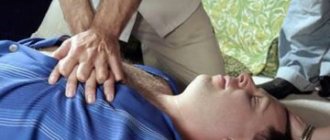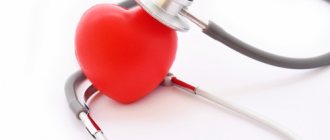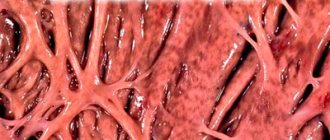Heart failure is the inability of the heart to pump the amount of blood the body needs. This disease occurs as a result of past infectious diseases. Heart failure is the most common cause of sudden death in pets. It affects not only dogs, but also cats.
Types of heart failure:
- Chronic heart failure. It develops slowly, sometimes imperceptibly, but at the same time, steadily.
- Acute heart failure develops quite rapidly, its time varying from several minutes to several hours.
As a result of the acute form, the cat instantly develops pulmonary edema, symptoms of which may include blood discharge from the mouth and nose, as well as shortness of breath.
Symptoms
Symptoms of heart disease in cats are not always visible, but she cannot complain about her health. Therefore, the health of the pet is entirely in the hands of the owner. He must monitor his pet and, upon discovering the first symptoms of the disease, should seek advice from a veterinarian.
A cat's panting with a protruding tongue is a sign of heart disease.
- Fatigue is difficult to notice in a cat, since it leads a generally quiet lifestyle.
- Dyspnea. Breathing occurs through the abdomen, without the participation of the chest.
- An attack accompanied by loss of consciousness. The cat, at this time, can be mistaken for a dead animal. Usually the attack passes quickly, but it happens that pets die, as their body experiences an acute lack of oxygen.
- The animal wheezes and meows terribly.
- Heavy breathing indicates pulmonary edema.
- Complete or partial paralysis of the hind legs.
- Cardiopalmus.
- Cyanosis of the gums.
- Loss of appetite.
In cats, coughing is not a cardiac symptom.
First aid for a cat who faints
The onset of an attack requires quick and correct actions by the owner, since, sometimes, it can end in death.
- Lay the cat down, and it is necessary to give her a side position of her head.
- Pull out your tongue.
- Place a cool compress on your head.
- Place cotton wool soaked in ammonia to your nose.
- The paws must be fixed higher than the head, so there will be more blood flow to the head.
- Call your veterinarian.
How to distinguish a healthy cat from a sick one
Since cats generally lead a calm lifestyle, they are couch potatoes, not all owners can distinguish a healthy animal from a sick one. She can report any changes in well-being by changing her behavior, that is, if the cat used to behave independently of the owner, but now does not leave him, then this indicates that something is bothering her.
Some people think that purring in cats is a sign of health. This is wrong. Purring, abruptly replaced by aggression or growling, indicates that she is in pain.
A healthy animal has:
- Smooth wool.
- The nose is wet and cold.
- The mucous membranes of the eyes are pinkish in color.
- The animal is vigorous and active.
Sick animal:
- Lethargic, lies more than usual.
- He tries to get away from everyone to a secluded place.
- Can be very excited.
- The meow is pitiful.
- Movements are clumsy.
- The nose is warm with cracks.
Hypertrophic cardiomyopathy is the most common heart disease in cats. Interview with a cardiologist
We talked about the most common cardiac disease in cats with the head of the cardiology department, veterinary cardiologist, candidate of biological sciences Vladislava Konstantinovna Illarionova.
— Do cats have heart disease?
- Yes, there are. A cat's small heart can indeed be unhealthy, and the most common pathology is a chronic heart muscle disease called cardiomyopathy. In fact, cardiomyopathies are a whole group of myocardial diseases that slowly progress and in some animals lead to chronic heart failure, blood clots and sudden death. Heart disease is one of the ten most common causes of death in cats.
— What heart disease is most common in cats?
— Hypertrophic cardiomyopathy is the most common form of feline cardiomyopathy. The disease is characterized by thickening of the heart muscle, which is called “hypertrophy”. This is a progressive pathology that hardens the walls of the heart, reducing the ability of the ventricular chambers to effectively draw in and eject blood. In addition, such changes in the myocardium can affect the functioning of the heart valves, causing incompetence that aggravates the pathological process. Often, transformations of the walls of the heart lead to the formation of fast flows in the chambers and vessels, which cause the characteristic noise heard with a stethoscope. With the development of heart failure, the body compensates for the circulatory deficiency by increasing the frequency of heart contractions, as well as retaining salt and water. For some time, such adaptation mechanisms maintain normal blood flow, but over time, the body's resources are depleted and clinical signs of the disease begin to develop.
— How common is this disease?
— Hypertrophic cardiomyopathy is detected in approximately 15% of cats in the general population. In older cats, the prevalence reaches 29%. Most cats with hypertrophic cardiomyopathy are asymptomatic, with an incidence of cardiac death of approximately 23% within 5 years, regardless of age at diagnosis.
— What is the reason for the development of the disease?
— Most often we call such diseases idiopathic, that is, without a clear cause. However, more and more data support the genetic nature of the pathology. Here, however, it is important to say that the possible reasons may be heterogeneous. Similar changes develop in the heart secondary to high blood pressure (which is not uncommon in cats) or chronic pathology of the thyroid gland. In addition, in cats, due to stress, a pathological process in the heart can acutely occur, which is called transient myocardial hypertrophy and is most likely associated with an inflammatory reaction of the heart muscle. Such changes are sometimes recorded in cats after general anesthesia, changes in their usual lifestyle, moving, the appearance of new members in the family, and so on. Clinically, this is manifested by shortness of breath and apathy, which usually occurs 3-5 days after the event.
— Which cats are predisposed to this disease?
— Although most cats with hypertrophic cardiomyopathy are mongrel, some breeds have an increased risk of developing the pathology. These include Maine Coons, Ragdolls, British Shorthairs, Persians, Bengals, Sphynxes, Norwegian Forest cats and Burmese. However, data on the prevalence of the disease in breeding animals of different breeds is not complete. Two contractile protein gene mutations have been identified in the myosin binding protein C (MyBPC3) gene. The estimated prevalence of the MyBPC3-A31P mutation in Maine Coon cats is 35% to 42%, which is significantly higher than the prevalence of the disease in this breed. Maine Coons homozygous for this mutation, ragdolls homozygous for the MyBPC3-R820W mutation, and kittens of affected animals are at risk of developing hypertrophic cardiomyopathy.
— If the hereditary nature of the disease is proven, is there a test for early detection of pathology?
— Genetic testing for the MyBPC3-A31P and MyBPC3-R820W mutations is recommended for Maine Coon and Ragdoll cats. Tests are carried out on animals involved in breeding in order to reduce the frequency of mutations in these breeds. It is recommended to remove from breeding cats homozygous for these mutations, but leave the possibility of crossing heterozygous animals with cats negative for mutations if they have outstanding breed characteristics. Genetic tests can also be used in non-breeding Maine Coon or Ragdoll cats to determine the relative risk of developing the disease. However, Maine Coon and Ragdoll cats that test negative for the MYBPC3 mutation also have hypertrophic cardiomyopathy and, therefore, the only reliable diagnostic method is regular echocardiographic examination. For cats of other breeds, genetic testing of the MYBPC3-A31P and MYBPC3-R820W mutations is not recommended, since these mutations have been identified only in Maine Coon and Ragdoll animals.
— What symptoms are typical for heart disease in cats?
— Chronic heart failure is the most common cause of clinical signs in cats with hypertrophic cardiomyopathy. In second place is arterial thromboembolism. Sudden death without clinical manifestations is recorded in a small number of patients. There are two main mechanisms for the development of symptoms. The first is associated with an increase in pressure in the veins of the lungs due to the fact that blood is poorly pumped by the heart - this leads to the sweating of its liquid part into the lung tissue. This condition is called “pulmonary edema” and can lead to the death of the animal. The main symptom is shortness of breath. The frequency of inhalations exceeds 30 per minute at rest or during sleep, movement of the chest becomes noticeable when breathing, and sometimes the mouth opens slightly. Often such signs are accompanied by depression, reluctance to play, communicate, and eat. The cat finds a secluded place and does not agree to be persuaded to leave. Pulmonary edema is often accompanied by the accumulation of free fluid in the chest, which further aggravates the condition.
The second mechanism for the development of symptoms is associated with the formation of blood clots in the cavity of the enlarged left atrium. Such blood clots form as a result of disruption of blood flow through the heart and can reach significant sizes. The greatest danger arises from the leaching of these clots into the systemic circulation. If a thrombus goes into the vessels of the systemic circulation, then the symptoms depend entirely on its diameter and location. Most often, the thrombus stops at the site of bifurcation of the abdominal aorta into the vessels of the pelvic limbs. This causes a sudden loss of support on the hind legs, severe pain and fear. The cat cannot get up and screams pitifully. This condition is very life-threatening and the prognosis is largely determined by the diameter of the blood clot and the time between the onset of symptoms and the start of treatment. If more than 4 hours pass from the moment of the first manifestations, the prognosis worsens significantly.
— How can this disease be diagnosed?
— The main method for diagnosing feline cardiomyopathies is echocardiographic examination (ultrasound of the heart). This is a method that provides comprehensive information about the structure and function of an organ. There are a number of clear criteria for identifying pathology, which are based on the anatomical landmarks of the thickness of the walls of the heart, the shape of the thickenings, the nature of the movement of the heart muscle, and the parameters of myocardial relaxation. In addition, there are signs by which the doctor can judge the risk of pulmonary edema and the presence of free fluid in the chest. Echocardiography is a very comfortable and safe method for our patients. It does not require anesthesia and is not associated with unpleasant sensations, so most cats tolerate it well. The study lasts about 20 - 30 minutes (sometimes a little more or less), after which the doctor carries out the necessary measurements and calculations and fills out a study protocol.
It must be said that cardiologists often do not limit themselves to one research method, but carry out diagnostics in a comprehensive manner. Therefore, after echocardiography, we proceed to an electrocardiographic study (ECG), which provides invaluable information about the heart rhythm. The condition of the lungs, respiratory tract, and vessels of the chest can be assessed using an X-ray examination, and if a detailed layer-by-layer view of all structures of the chest organs is necessary, computed tomography is performed. Another important step in diagnosing heart disease is measuring blood pressure. If the doctor still has doubts about the cause of the symptoms and he needs to differentiate the respiratory and cardiovascular systems according to the degree of importance of their influence on the formation of the clinical picture, then there is a diagnostic method such as determining the concentration in the blood or pleural fluid of natriuretic peptide, which is called a cardiac marker and increases with significant heart failure. Another auxiliary test is to determine the concentration in the blood of another cardiac marker - cardiac troponin I, which increases with the destruction of the myocardium and provides information about acute pathologies of the heart muscle, for example, such as transient myocardial hypertrophy (myocarditis).
— What is rapid echo screening?
“There are situations when life depends on emergency treatment measures. In this case, the doctor can simply "take a look" at the heart by performing a quick ultrasound examination of the chest. To do this, the cat is usually not fixed on its side, but screening is carried out in positions that are more comfortable for the animal - on the chest, standing or sitting. The fact is that if there is pulmonary edema or fluid accumulation in the chest, keeping the animal in a position on its side can cost it its life. Therefore, the doctor’s task is to quickly and with the least stress for the cat conduct a study for the presence of pulmonary edema, pleural effusion, and significant changes in the heart. This is necessary for choosing treatment tactics in the acute period and does not replace a full echocardiographic study after stabilization of the animal’s condition.
— Is it possible to cure the disease?
“Unfortunately, the vast majority of cardiomyopathies only change in the direction of worsening. The only exception is transient myocardial hypertrophy, which may completely resolve after a few months. However, treatment can prolong life and improve quality of life in patients with clinical signs. The main drugs for chronic therapy are diuretics, inhibitors of hormonal systems involved in the formation and development of heart failure, drugs that reduce the risk of thrombosis, antihypertensive and antiarrhythmic drugs, as well as drugs that improve the functioning of the heart muscle and dilate the blood vessels of the lungs.
— What do you need to know to properly care for a sick animal at home?
— A very important factor for cats is a calm and comfortable environment. Any changes in the usual environment have a bad effect on a sick animal. So you shouldn’t take other animals, change the cat’s diet or habitual lifestyle. It is very important to follow the medication administration schedule. Over time, this becomes a habit for both the owners and the patient. A great help for monitoring the condition of the animal is to count the frequency of respiratory movements. This procedure is usually carried out when the cat is calm or sleeping. To count, take a minute and record the number of breaths. The upper limit of normal is 30 breaths per minute, although in cases of severe chronic illness the frequency may be slightly higher. In any case, this should definitely be discussed with your doctor. In addition, it is necessary to discuss with the doctor the schedule of repeated examinations and the possibility of communication in emergency situations.
Causes of heart failure
- Congenital heart pathologies. In cats they are quite rare, occurring in approximately 2% of all cases.
- Diseases of the heart muscle caused by infectious diseases.
- Cardiomyopathy, which is caused by an inadequate diet in cats. They, as a rule, do not receive enough taurine, which is part of raw fish and meat. During cooking, it is destroyed.
- Heartworms and their larvae are found in mosquitoes. They are microscopic in size. When a mosquito bites, their larvae enter the animal’s bloodstream and settle in the pulmonary artery. Heartworms can grow up to 30 centimeters in size. With their presence in the circulatory system, they interfere with the outflow of blood and cause enormous damage to the arteries. Adults entangle the heart, thereby interfering with its full functioning. Heartworms can be detected using a blood test.
- Age-related hormonal changes. Heart failure is thought to occur in cats over 6 years of age.
- Metabolic disease. Sometimes it is caused by improperly structured nutrition.
Cats should be periodically screened for heartworms to help prevent heart disease. If a taurine deficiency is noticed in a timely manner, it must be introduced into the cat’s food, due to which the vital activity of the heart muscle is restored.
Diagnostics
Diagnosis must be carried out by a qualified veterinary cardiologist in order to prescribe the correct treatment. Typically it includes:
- Blood analysis.
- Analysis of urine.
- Ultrasound.
- Chest X-ray.
- ECG.
If a cat has been diagnosed with heart failure, then it should be excluded from planning for breeding, since the hereditary factor plays an important role.
Diagnostics
To make a diagnosis, carry out:
- Anamnesis collection, including the nature of visible manifestations and the time of their onset.
- Appearance of the animal. Congestion in the left and right sections has different development mechanisms, which is reflected in the appearance of the cat.
- Physical examinations. Standard percussion and auscultation is an informative method for diagnosing cardiac pathologies. They allow you to detect the expansion of the boundaries of the organ and hear noises without resorting to expensive procedures.
- Lab tests. With chronic damage to the heart muscle, changes in the results of clinical and biochemical studies can be detected.
- Instrumental examination. X-ray allows you to see changes in the shape and size of the heart, but the decisive method in making a diagnosis is echocardiography, which allows you to visualize the movement of blood through the chambers, assess the functional state of the valves and walls, and determine the load volume.
- In some cases, cardiac catheterization is performed, which is considered a specific method. Using a flexible tube inserted into the heart cavity, not only the functional, but also the anatomical condition of the walls and septa are assessed.
Treatment and care
Treatment of cats for this disease depends on the severity of the disease. Sometimes it is carried out exclusively during a daily stay in a veterinary clinic. Cats do not undergo heart surgery. During illness, they are prescribed only drug treatment. The earlier they are diagnosed with heart failure, the better their chances of survival. For recovery you need:
- Complete rest of the animal. The pet must be limited from any stress - this could be a working vacuum cleaner, traveling on public transport or the arrival of guests.
- Treatment with diuretics removes excess fluid from the body. During illness, fluid can accumulate near the lungs, thereby causing swelling. In the chest, causing pleurisy. In the abdominal cavity, causing ascites. Reducing the amount of fluid in the body helps reduce the load on the heart.
- Treatment with ACE inhibitors, which reduce the load on the heart by increasing blood flow.
- Positive inotropes make the heart pump more blood, control the heartbeat, and slow it down so it pumps more blood into the body.
- When the fluid content in a cat’s body is greatly increased, the veterinarian will pump it out and thereby remove it from the body. The cat will feel relief for a while, but this will not last long, as the fluid will return. Pumping is carried out by inserting a sterile needle into the required place.
- Balanced diet.
Heart failure in an animal requires careful care:
- Cats need low-salt food. Salt retains water in the body, which leads to poor circulation.
- Feed with a high content of taurine and protein.
- Heart failure requires regular veterinary consultations and ongoing treatment.
Types of heart disease in cats
According to the Cornell University Feline Health Center, cats can have different types of heart disease, but the most common is cardiomyopathy. This is a condition in which the left atrium muscles thicken, making it difficult to pump blood. As a result, fluid begins to accumulate in the lungs, a process also called congestive heart failure.
Hypertrophic cardiomyopathy is the most common type of cardiomyopathy, writes Cornell University. It is considered a hereditary disease and can affect cats of all ages, but is most often diagnosed in older animals. Cats can also develop cardiomyopathy due to a deficiency of the essential amino acid taurine. Pets that eat only fish (which is naturally low in taurine) run the risk of heart damage.
Older cats can develop cardiomyopathy as a result of scar tissue gradually forming inside their heart. This occurs in approximately 10% of cases of cardiomyopathy. Cornell University also notes that congenital heart defects are rare, affecting only 1-2% of all kittens.
Prevention
Cats suffering from heart failure need preventative care to keep them active. We need to try to “stir up” animals that lead a “sofa” lifestyle. Obese cats are at risk for heart disease. You need to ensure your pet is eating properly. An annual checkup with a veterinarian will protect him from heart disease.
Sphynx, British, Persian, Scottish cats, and Maine Coons are also susceptible to heart disease. This does not mean that all cats of these breeds, sooner or later, have heart problems. This statement means that representatives of these breeds develop heart disease at an earlier age.
Heart failure in neutered cats is quite common because these animals are very lazy. They lead a sedentary lifestyle and are obese.
It is necessary to pay increased attention to neutered cats, as they are more susceptible to heart disease.
A diagnosis of heart failure in cats is not a death sentence. The main thing is to notice the first symptoms of the disease in time, carry out regular examination and treatment. Monitor your pet's diet. With proper care and care, a cat can delight its owner with affection and beauty for a long time.
Mechanism of disease development
There are several types of pathologies in the heart area. The first type is valve disease, characterized by a decrease in the amount of blood entering the body due to blood leaking through the valve itself. The second type of pathology is myocardial diseases, characterized by a general weakening or thickening of the heart muscle, which results in a decrease in the efficiency of blood pumping.
There is no single common cause for the development of heart pathologies. But problems with diet are more likely to lead to cardiovascular disease. In addition, the mechanism for the development of heart disease is based on the general physical condition of the animal. Thus, cats that are overweight are more often susceptible to pathological conditions of the myocardium.
The age of the pet plays an important role, because the older the pet, the higher the likelihood of developing cardiomyopathies. Some cat breeds, such as American Shorthairs, Maine Coons and Persians, have a genetic predisposition to developing heart disease.
Description of the disease
To put it simply, this is not one disease, but several, i.e.
complex of diseases. But they all lead to disruption of its contractile function. It follows from this that they lead to impaired blood circulation throughout the cat’s body. It is worth taking this as seriously as possible, because the animal’s body is literally balancing “on the brink.”
In critical cases (that is, this is not always the case), the “power” of the heart is only enough to supply tissues and organs with oxygen and various nutrients only in a calm state.
It's terrible, but when he comes out of this state, for example, he starts jumping and running, he shows signs of asphyxia.
Important!
It is worth noting that heart failure in cats (unlike in humans) is uncommon.
The fact that this phenomenon is rare is due to the biochemistry of cats. More precisely, their body. This was also linked to the nutritional characteristics of cats. Most often, the described disease develops in animals that are at least 6 years old.
But, unfortunately, there are exceptions. Sometimes this diagnosis is made at the age of one and a half years. This happens in cases with a congenital defect.









